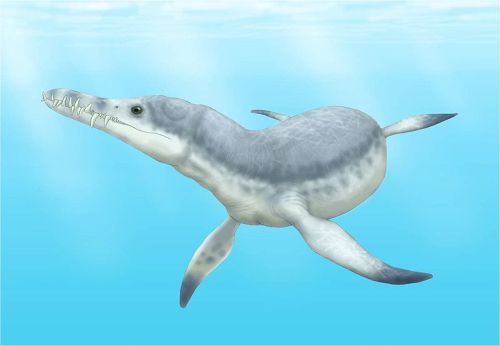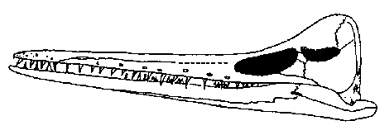
Life reconstruction of the basal polycotylid Edgarosaurus muddi., Early Cretaceous (late Albian) of Montana (Western Interior Seaway).
Artwork by Smokeybjb. Wikipedia, GNU Free Documentation/Creative Commons Attribution
| Sauropterygia | ||
| The Vertebrates | Polycotylidae |
| Vertebrates Home | Vertebrate | Vertebrate |
|
Abbreviated Dendrogram
Diapsida
├─Archosauromorpha
└─Lepidosauromorpha
├─Sauropterygia
│ ├─Placodontia
│ ├─Pachypleurosauridae
│ └─┬─Nothosauridae
│ └─Plesiosauria
│ ├─Pliosauroidea
│ └─Plesiosauroidea
│ ├─Elasmosauridae
│ └─Cryptocleidoidea
│ ├─Cryptocleididae
│ └─Tricleidia
│ ├─Tricleidus
│ └─┬─Cimoliasauridae
│ └─Polycotylidae
│ ├─Plesiopleurodon
│ └─┬─Trinacromerum
│ └─Dolichorhynchops
│ ├─Dolichorhynchops osborni
│ └─Dolichorhynchops bonneri
└─Lepidosauriformes
├─Sphenodontia
└─Squamata
|
Contents
Overview |
 Life reconstruction of the basal polycotylid Edgarosaurus muddi., Early Cretaceous (late Albian) of Montana (Western Interior Seaway). Artwork by Smokeybjb. Wikipedia, GNU Free Documentation/Creative Commons Attribution |
Dolichorhynchops: T. bonneri (Adams 1997), D. herschelensis Sato 2005., D. osborni Williston 1903
Range: Late Cretaceous (Santonian to Maastrichtian) of North America.
Phylogeny: Polycotylidae : Plesiopleurodon + (Trinacromerum + * : Dolichorhynchops osborni + Dolichorhynchops bonneri)
Characters: polycotylid plesiosaurs possessing 19 or 20 cervical vertebrae; 18-20 teeth in mandibular symphysis; short and very high sagittal crest; O'Keefe 2008
Links: Dolichorhynchops - Oceans of Kansas Paleobiology database; MAK111126

Dolichorhynchops osborni: Williston 1903 .
Range: Hesperornis zone, Smoky Hill Chalk Member, Niobrara Formation. Santonian-Campanian (Late Cretaceous) of North America.
Phylogeny: Dolichorhynchops : Dolichorhynchops bonneri + *
Comment: a relatively small polycotylid plesiosaur, (O'Keefe 2008) which lived slightly earlier than, but was otheriwsie very similatr to, D. bonneri. It is not impossible that this could be an ancestral species for the more advanced, later, larger and faster D. bonneri. If so, this would be an example of progressive evolution similar tpo that of the contemporary Tyrannosaurs on land, which likewise evolved into progressively larger and more formiable species during this same time period MAK111126
History of discovery: The following is from the Wikipedia entry on Dolichorhynchops: "The holotype specimen of Dolichorhynchops osborni was discovered in the upper Smoky Hill Chalk Logan County, Kansas, by George F. Sternberg, as a teenager, in around 1900. The remains were collected by him and his father, Charles H. Sternberg, and then sold to the University of Kansas (Lawrence, Kansas). KUVP 1300 was prepared and mounted by H.T. Martin under the supervision of Dr. Samuel Wendell Williston, who described and named it in 1902. A more detailed description and photographs were provided by Williston 1903). The specimen has been on display in the KU Museum of Natural History since that time.
George Sternberg found a second, less complete specimen of D.osborni in 1926. In his effort to sell the specimen to a museum, Sternberg took detailed photographs of the skull. The specimen was eventually mounted in plaster and was acquired by the Harvard Museum of Comparative Zoology. MCZ 1064 was on display there until some time in the 1950s. This specimen was never completely described although the skull was figured by O'Keefe (2004). (See also Everhart, 2004)
The specimen of D. osborni on exhibit at the Sternberg, FHSM VP-404 was found by Marion Bonner near Russell Springs in Logan County in the early 1950s. It is, perhaps, the most complete specimen of this species known. It is just under 10 feet (3 meters) in length. The skull was crushed flat but is in very good condition. This specimen was initially reported by Sternberg and Walker (1957), and then was the subject of a Masters thesis by Orville Bonner (1964). Note that it was described by Bonner as "Trinacromerum osborni" which was the accepted genus name at the time."
Graphic: Mounted skeleton of the Holotype of Dolichorhynchops osborni (from Williston, 1903), in the University of Kansans Museum of Natural History. Wikipedia, Public domain. MAK111126

Dolichorhynchops bonneri: (Adams 1997),
Synonym: Trinacromerum bonneri
Range: Sharon Springs Member, Pierre Shale of Wyoming & South Dakota, Taylor Marl of Texas. Early Campanian (Late Cretaceous)
Phylogeny: Dolichorhynchops : Dolichorhynchops osborni + *
Characters: See O'Keefe 2008
Comments One of the last, largest, and fastest of the Polycotylids. The taxonomy is very confusing, we have followed O'Keefe 2008.
[1] History of discovery. From Wikipedia: "Two very large specimens of a polycotylid plesiosaur (KUVP 40001 and 40002)were collected from the Pierre Shale of Wyoming and later reported on by Adams in her 1977 Masters thesis. Later (1997), she officially described (1997) as a new species of Trinacromerum (T. bonneri). Unknown to her at the time, Carpenter (1996) had revised the Polycotylidae and separated Dolichorhynchops from Trinacromerum. Thus the species would revert back to Dolichorhynchops bonneri"
[2] Phyogeny : From the abstract of O'Keefe 2008: "The taxonomic identity of two well-preserved polycotylid plesiosaur skeletons from the Pierre Shale of far northern Wyoming and southern South Dakota has been controversial since their discovery. Originally referred to Dolichorhynchops osborni, the material was almost immediately christened Trinacromerum bonneri Adams 1997; more recently the material has been referred to Polycotylus. Recent preparation of the well-preserved skull of one specimen permits detailed examination of the cranial morphology of this animal for the first time, and allows for its inclusion in a cladistic analysis of the Polycotylidae. This analysis reveals a stable sister-taxon relationship with Dolichorhynchops osborni. However, the taxon possesses a bewildering mosaic of character states, superficially resembling Polycotylus in overall size and tooth morphology and Trinacromerum in details of the palate and lower jaw, while sharing several critical synapomorphies with Dolichorhynchops osborni. This wide-ranging homoplasy among characters previously diagnostic among polycotylid genera challenges the alpha taxonomy of forms from the western interior seaway."
[3] Ecology: Phyogeny : From the abstract of Adams 1997 "The Pierre Shale represents the final days of the Western Interior Seaway before its regression at the end of the Mesozoic, and records the last of the marine reptiles that dominated the seas much as their contemporary dinosaur counterparts dominated the land. Trinacromerum bonneri , n.sp., is the first pliosaur (short-necked plesiosaur) to be described from this formation in the northern Great Plains; as such it represents the final radiation of polytcotylid plesiosaurs in North America. Pliosaurs have long been regarded as particularly high-speed swimmers, but in T. bonneri this trend is carried to an extreme. Development of the longest wingfins known in pliosaurs maximised its velocity. Unique limb and vertebral structures resisted pressures of the surrounding water that were generated by its own swimming velocity. Such adaptations include tongue-and-groove articular surfaces between critical limb elements and highly interlocking vertebrae."
Graphic: David Peters - Reptile Evolution
Plesiopleurodon: P. wellesi Carpenter 1996.
Range: Early Late Cretaceous (Cenomanian) of North America.
Phylogeny: Polycotylidae : Plesiopleurodon + (Trinacromerum + Dolichorhynchops)
Characters: relatively small (<3m); mandible with moderately long symphysis containing 8 pairs of large procumbent caniniform teeth; teeth circular in cross-section, with outer surface smooth except near base, which is striated; cervical vertebrae slightly wider than long; cervical ribs single-headed.
Comment: originally interpreted as a standard pliosaurid, appears as a basal Polycotylid in cladistic analysis by Hilary Ketchum and Roger Benson 2010, 2011
Links: Questions and Answers Late July 2001 -Zoom Dinosaurs; Plesiosauria Translation and Pronunciation Guide. ATW020705, revised MAK111126
 Polycotylidae: Ceraumasaurus, Dolichorhynchops, Georgiasaurus, Polycotylus, Trinacromerum.
Polycotylidae: Ceraumasaurus, Dolichorhynchops, Georgiasaurus, Polycotylus, Trinacromerum.
K.
Tricleidia : Tricleidus + (Cimoliasauridae + * : Plesiopleurodon + (Trinacromerum + Dolichorhynchops))
Short-necked, long-jawed elasmosaurs, up to 9m. Very long, slender premaxilla and maxilla; premaxilla forms dorsal & anterior margin of nares; dorsal process of premaxilla extends posteriorly to separate frontals and meet the parietals between the orbits (!!); replacement teeth grow in pits medially to extant teeth; pineal foramen closed dorsally; thin vomer separates premaxillae with anterior V-shaped slit possibly housing chemosensory vomeronasal (Jacobson's) organ; maxilla also extends posteriorly and forms much of lower rim of orbit; lachrymal absent; frontals form upper orbit and have wing-like process over top of orbit; temporal fenestrae very large, leaving parietal as a sort of tall, central, tent-like crest covering the braincase; large pterygoids, ectopterygoids and palatines cover most of ventral surface, leaving two small vacuities posterior to body of the parasphenoid process, and one small medial vacuity anterior to the parasphenoid; dentaries bear splenials and coronoids; quadrate short, wide & articulates with large squamosal and quadrate process of pterygoid; basioccipital forms ventro-posterior margin of braincase; stapes absent; cervical ribs are single-headed; scapular is separated by clavicular arch; pelvis large, with elongated ischia; distal bones of limbs very short.
Links: Kazmer's Trinacromerum bones; Royal Tyrrell Museum Tour: Bearpaw Sea; TMM - Exhibits - Scratching the Surface - Plesiosaur; The Plesiosaur Site - Species; Marine Reptiles (NOT Dinosaurs); Plesiosauria Translation and Pronunciation Guide; ???????? Japanese). The Sternberg site at Oceans of Kansas has an exceptional number of good images. ATW020709. MAK990821.
Trinacromerum: T. bentonianum Cragin 1888, T. kirki Russell, 1935
Synonym: Ceraunosaurus
Range: Early Late Cretaceous ( late Cenomanian/early Turonian) of North America.
Phylogeny: Polycotylidae : Plesiopleurodon + (Dolichorhynchops + *)
Comment: Similar to but earlier than Dolichorhynchops.
Links: Trinacromerum - Oceans of Kansas Paleobiology database; Trinacromerum (Julius T. Csotonyi); (paleo art) MAK111126
checked ATW040131. New page MAK111126
Using this material. All material by ATW is public domain and may be freely used in any way (also any material jointly written by ATW and MAK). All material by MAK is licensed Creative Commons Attribution License Version 3.0, and may be freely used provided acknowedgement is given. All Wikipedia material is either Gnu Open Source or Creative Commons (see original Wikipedia page for details). Other graphics are copyright their respective owners